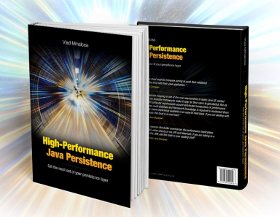How to map the latest child of a parent entity using Hibernate JoinFormula
Imagine having a tool that can automatically detect JPA and Hibernate performance issues. Wouldn’t that be just awesome?
Well, Hypersistence Optimizer is that tool! And it works with Spring Boot, Spring Framework, Jakarta EE, Java EE, Quarkus, or Play Framework.
So, enjoy spending your time on the things you love rather than fixing performance issues in your production system on a Saturday night!
Introduction
In this article, I’m going to explain how the Hibernate JoinFormula annotation works and how you can use it to map the latest child of a parent entity.
As previously explained, the @JoinFormula is a very awesome annotation which allows you to customize the way you join entities beyond JPA @JoinColumn capabilities.
Domain Model
For the upcoming test cases, we are going to use the following entities:

The PostComment entity is mapped as follows:
@Entity(name = "PostComment")
@Table(name = "post_comment")
public class PostComment {
@Id
private Long id;
@ManyToOne(fetch = FetchType.LAZY)
private Post post;
private String review;
@Column(name = "created_on")
@Temporal(TemporalType.TIMESTAMP)
private Date createdOn;
//Getters and setters omitted for brevity
}
Not only the PostComment has a @ManyToOne association to a Post, but the Post is also associated with the latest PostComment as follows:
@Entity(name = "Post")
@Table(name = "post")
public class Post {
@Id
private Long id;
private String title;
@ManyToOne(fetch = FetchType.LAZY)
@JoinFormula("""
(SELECT pc.id
FROM post_comment pc
WHERE pc.post_id = id
ORDER BY pc.created_on DESC
LIMIT 1)
"""
)
private PostComment latestComment;
//Getters and setters omitted for brevity
}
The latestComment attribute associates the parent Post entity with the latest PostComment child entity. The @JoinFormula annotation allows us to define any SQL select query to provide the relationship between two entities.
Testing the Hibernate JoinFormula annotation
Considering we have the following entities in our database:
Post post = new Post()
.setId(1L)
.setTitle("High-Performance Java Persistence");
entityManager.persist(post);
assertNull(post.getLatestComment());
entityManager.persist(
new PostComment()
.setId(1L)
.setPost(post)
.setCreatedOn(
Timestamp.valueOf(
LocalDateTime.of(2016, 11, 2, 12, 33, 14)
)
)
.setReview("Woohoo!")
);
entityManager.persist(
new PostComment()
.setId(2L)
.setPost(post)
.setCreatedOn(
Timestamp.valueOf(
LocalDateTime.of(2016, 11, 2, 15, 45, 58)
)
)
.setReview("Finally!")
);
entityManager.persist(
new PostComment()
.setId(3L)
.setPost(post)
.setCreatedOn(
Timestamp.valueOf(
LocalDateTime.of(2017, 2, 16, 16, 10, 21)
)
)
.setReview("Awesome!")
);
When we fetch the Post entity, we can see that the latestComment attribute works as expected:
Post post = entityManager.find(Post.class, 1L);
PostComment latestComment = post.getLatestComment();
assertEquals("Awesome!", latestComment.getReview());
I'm running an online workshop on the 20-21 and 23-24 of November about High-Performance Java Persistence.
If you enjoyed this article, I bet you are going to love my Book and Video Courses as well.
Conclusion
As I explained in my book, High-Performance Java Persistence, if you don’t take advantage of the underlying JPA provider or relational database capabilities, you are going to lose lots of features.











